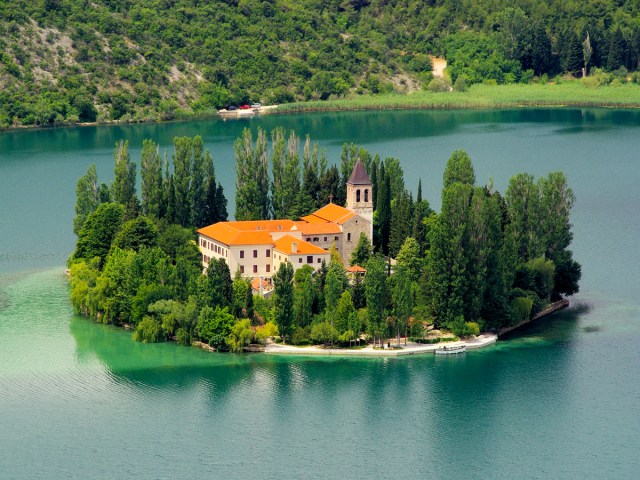Monasteries are places of peaceful contemplation, home to religious communities who value seclusion as they seek enlightenment and serve whatever higher power they believe in. Many monasteries were built centuries ago, and you’ll find them in a wide variety of settings — some of which are highly unusual and, often, tricky to reach. Visit these seven architecturally stunning monasteries built in unlikely locations.
Katskhi Pillar – Georgia

This tiny church — perched precariously on a slim limestone pillar high above the surrounding countryside — is one of the most remarkable pilgrimage sites in Georgia, a country in the Caucasus region bordering Europe and Asia. Monks began living here as early as the 10th century, though the church itself predates that by several centuries. Monks stopped practicing at Katskhi in the 15th century when the Ottomans arrived in the country, but the rock was scaled again in 1944, when three monastic cells and a wine cellar were discovered.
A few decades later, a monk named Maxime Qavtaradze renovated the monastery and installed a 130-foot iron ladder to access it. He remained there until 2015, but no one has replaced him permanently. The Georgian Orthodox Church forbids visiting tourists from climbing all the way to the top, but they may access the prayer area on a lower level.
Xuankong Monastery – China

Xuankong Monastery makes an arresting first impression, appearing as a gravity-defying complex suspended from a cliff face overlooking Jinxia Gorge in China’s north-central Shanxi Province. On closer inspection, visitors will see a series of wooden beams and platforms that anchor the temple pavilions into the rock of Hengshan Mountain, giving the site its “Hanging Temple” nickname.
Xuankong has stood here for over 1,500 years and remains a remarkable sight — even more so when you learn that it was the work of a lone, industrious monk in 491 CE. Interestingly, the location isn’t the only unusual aspect of this temple — it’s shared between multiple religions. Taoism, Confucianism, and Buddhism are practiced together in the Sanjiao Hall, whose name translates to “three religions.”
Debre Damo – Ethiopia

Debre Damo is located in southern Ethiopia high on a flat-topped mountain. To reach it, monks and male visitors are hauled up a 49-foot-high cliff face on a plaited leather rope. Female visitors are not permitted to enter and must remain at the foot of the cliff.
The origins of this colorful monastery are a little hazy, but historians generally believe that Debre Damo was founded by monk Abuna Aregawi during the reign of King Gebre Meskel in the sixth century. The monastery’s church, dating from the 10th or 11th century, is thought to be the oldest in this East African country. It was known for its Aksumite architecture, ancient manuscripts, and other religious treasures, though, sadly, it was heavily looted and badly damaged during the Tigray War in 2021.
Visovac Monastery – Croatia

Visovac Monastery (pronounced “vee-so-vatz”) is located in the middle of a river in Croatia’s Krka National Park. The monastery is situated on a small, oval-shaped island ringed by cypress trees. It dates to the 14th century when Augustinian monks constructed a church on the island. Later, in 1445, a group of Franciscan monks fled Bosnia, took over the monastery, and enlarged it.
The complex visitors see today is a new monastery that was built in the 18th century, after the older one had fallen into disrepair and had to be demolished. It houses a collection of rare manuscripts and books, including an illustrated copy of Aesop’s Fables printed in 1487.
Taung Kalat – Myanmar

Taung Kalat (meaning “Pedestal Hill”) overlooks its surroundings from the top of an extinct volcano, close to Mount Popa in Myanmar’s Mandalay region. The site for this Buddhist monastery was chosen so that followers could worship the nats, spirits thought to bring good fortune and protection, which are said to live here.
To reach Taunt Kalat’s gold stupas, pilgrims and monks climb 777 steps, which wind around a rocky crag that started out as a volcanic plug. In doing so, they must also navigate a population of mischievous macaques, primates who might like nothing better than to steal food, water bottles, hats, sunglasses, and any other loose items from careless tourists. If you visit, look out for novice monks in pink robes and rarely-seen yetis — in this case, not the hairy Himalayan creatures, but rather hermit monks recognizable from their peaked caps.
Santa Catalina – Peru

Many monasteries are located in remote places — the isolated settings prove ideal for meditation and meaningful prayer. So, to find a working monastery in the middle of a large urban area might come as a surprise. Santa Catalina is just that: Located in Arequipa, Peru’s second-largest city, it was founded in 1580 by a wealthy widow named Doña María de Guzmán.
Initially, the monastery consisted of cloisters for Dominican nuns from the 16th to the 18th centuries. The builders used a local white volcanic stone called Sillar; at Santa Catalina, it is painted in bold shades of coral pink and cobalt blue. Despite the heavy traffic from curious tourists, many of whom sign up for a guided tour, a community of around 20 nuns still lives in the northern part of the monastery.
Paro Taktsang – Bhutan

Improbably hugging the side of a sheer cliff that overlooks the Paro valley, Paro Taktsang is one of Bhutan’s 13 so-called “tiger lairs” — small monasteries said to have hosted the Buddhist master Padmasambhava in the eighth century. A Brahmin royal, Padmasambhava spread Tantric Buddhism throughout Tibet and Bhutan and is considered as nearly as holy as the Buddha himself in the region. Legend has it he arrived at Paro Taktsang on a flying tiger and meditated in a mountainside cave for months before subduing local demons and beginning to convert Bhutanese locals to Buddhism.
Visiting the monastery is not for the faint of heart: It’s a two-hour, 3,000-foot climb from the valley floor (already 7,000 feet above sea level). The trail, while well-maintained, is quite steep, with countless switchbacks that afford fleeting glimpses of the monastery through dense trees and frequent mists. From Paro Taktsang’s entrance, visitors descend a set of steps carved directly into the cliffside. These lead down into a secluded gorge, where you’ll be awed by a towering waterfall before heading up the other side and arriving at the actual monastery. After removing your shoes and climbing several more levels, you’ll reach the sacred cave where Padmasambhava himself is said to have meditated.
More from our network
Daily Passport is part of Optimism, which publishes content that uplifts, informs, and inspires.























